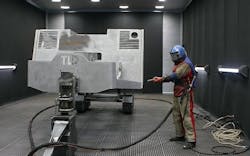TLD Invests in Paint Process
Surface treatment is a key aspect of the GSE production process. It not only ensures an optimal quality level for long-term rust protection, but is also an important factor in our Environment, Health & Safety policy (EH&S).
TLD DNA focuses on product durability and, in particular, how to face one of its biggest challenges: rust protection. All products are cleaned after final assembly, but only high-end, well-controlled surface treatments can ensure lasting protection. Over the past few years, TLD has developed Surface Treatment facilities in all its manufacturing sites. Recently, a new sandblasting and painting facility has been constructed at the Sorigny Factory in France, which enables the site to work on raw steel frames and ensures a comprehensive surface treatment.
This facility also enables greater flexibility in production, allowing us to accommodate specific customer requests, such as color schemes, whilst maintaining good control on the lead time, as well as our signature TLD Quality.
In Asia, the Wuxi – China factory also invested in a dedicated sandblasting and painting line in 2013, together with the development of the entire manufacturing plant. With three paint shops, TLD Wuxi can now fully control the quality level of surface treatments, and a dedicated electric heating system, with an ambient temperature of 60°C, enables a rapid paint-drying process.
As an industry leader, TLD must maintain up-to-date infrastructure, continually surpassing EH&S expectations. At Saint-Lin, France, the factory has installed a brand new pain lab, complementing the existing sandblasting and painting facility, in order to manage the paint preparation and mixing in a controlled environment that includes exhaust treatment, air conditioning and air filtering. This allows the company to constantly control the quality of the air emitted and the working conditions of our employees.
The company's employees do not inhale any chemicals and the solvent waste is not released into the environment.
Further investments will continue to be made on the automatic mixing system, reducing downtime while changing colors. This will not only increase productivity, but will also lead to many ergonomic improvements; cleaning the equipment will be faster and more efficient, and much fewer cans will be used.
